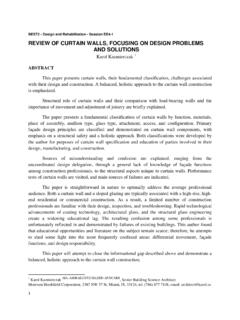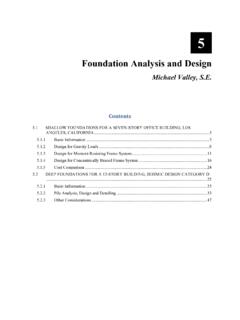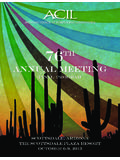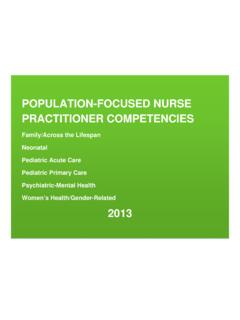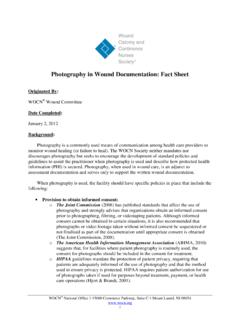Transcription of Spirituality and Social Work
1 YOU ARE HOLDING CEs IN YOUR HAND! How it works: Read this CE program, complete the post-test and evaluation and mail to the Chapter office with your check. Score 80% or better and NASW will mail you a certificate for your CEs. It's that easy! Spirituality and Social work Edna Lezotte, , LICSW, Private Practice COURSE DESCRIPTION. This course explores the interrelationship between Spirituality and the biological, psychological, and Social dimensions of human experience. Spirituality designates the human longing for a sense of meaning through morally responsible relationships between diverse individuals, families, communities, cultures and religions. In addition, this course will explain the important differences between organized religion and Spirituality . It will examine a variety of religions, ethnicities and culture, as well as discuss support groups which use belief in a higher power and perspectives that search for ultimate meanings and purposes.
2 This course is designed to enhance Social work practice by (a) recognizing and utilizing the qualities of a Spirituality sensitive helping relationship, and (b) acquiring knowledge about ways to deal with matters of the human spirit. Epistemologically, the course assumes that there are many avenues to human knowing. As such, this course explores various scientific approaches to studying the relationship between Spirituality , religion and health making a reductionist assumption that scientific methodologies are superior to critical philosophic ways of knowing, feeling and judging. Contributing to our understanding of religion and Spirituality are institutional religious beliefs imbedded in historical oral traditions, written scriptures, liturgical rituals, organized works of charity, and legal authority structures. Finally, the course explores how individuals view Spirituality and religion as they move through the life cycle, thereby integrating theories of human development.
3 LEARNING OBJECTIVES. Participants will be able 1. Understand and describe historical and existing relationships between religions and Social work . 2. Know the concepts of Spirituality and religion. 3. Learn guidelines for a Spirituality sensitive assessment of person and situation, and apply selected Spirituality - sensitive practice techniques in a manner consistent with professional ethics and self-determination. 4. Demonstrate how Spirituality /religion can be used as a way of coping with major losses, traumatic experiences, end-of- life issues, and chronic suffering. 1 FOCUS CE COURSE Spirituality and Social work Originally printed December 2010. DEFINITIONS. Spiritual / Spirituality Spirituality is an aspect of religious traditions, and also of existential value systems. Elkins (1988) gives this definition: Spirituality , which comes from the Latin, spiritus, meaning breath of life, is a way of being and experiencing that comes about through an awareness of a transcendent dimension and that is characterized by certain identifiable values in regard to self, others, nature, life, and whatever one considers the Ultimate (Elkins, 1988).
4 A spiritual belief holds that there is a transcendent, spiritual dimension to life and that the universe is unfolding in a meaningful, purposeful way. Spirituality is the belief that people can connect with something that is beyond mind and matter. Decker (1993). defines Spirituality as the search for purpose and meaning involving both transcendence (the experience of existence beyond the physical/psychological) and immanence (the discovery of the transcendent in the physical/psychological), regardless of religious affiliation. To be spiritual is to stand in a relationship to another based on matters of the soul. Spirituality is the way we make meaning out of our lives. It is the recognition of the presence of Spirit within us and a cultivation of a style of life consistent with that presence. Spirituality provides a perspective to foster purpose, meaning and direction to live.
5 It may find expression through religion . (Carson, 1989). In the Protestant tradition, Spirituality is usually referred to as devotion or piety. Roman Catholicism thinks of Spirituality as one's distinctive way of following Christ, communing with God, and growing in the life of faith. Spirituality in the modern Orthodox tradition has come to refer to a person's life and activity in relationship to God, and to oneself, other people, and all things in reference to God. Religion The concept of Spirituality is often confused with religion. Recent Social work literature includes a number of attempts to delineate these terms and distinguish them from one another. Edward Canda (1999) has analyzed the major themes in these various writings and proposes the following definitions: Religion involves the patterning of spiritual beliefs and practices into Social institutions, with community support and traditions maintained over time (p.)
6 303). Spirituality has also been defined as the beliefs and practices that develop based on personal values and ideology of the meaning and purpose of life. It refers to the belief that there is a power or powers outside of one's own that transcend understanding. It has been stated that there are three dimensions to Spirituality : 1. Making personal meaning out of situations 2. Coming to an understanding of self 3. Appreciating the importance of connections to others Wilfred Cantwell Smith defines religious faith as the way in which an individual lives out his/her religious tradition. Religious faith is not only what is espoused, but what is operationalized in one's orientation of the personality, to itself, to one's neighbors, to the universe. It is a total response, shaped by a religious tradition's understanding of a transcendent dimension (Smith, 1983). Religion is a personal awareness or conviction of the existence of a supreme being or of supernatural powers or influence, controlling the destiny of the individual, humanity, and nature (Webster's Third International Dictionary 1986).
7 Religion is a system of beliefs, values, rules for conduct, and rituals. It is a way a person's Spirituality is expressed. Ideally, religion provides an atmosphere for spiritual development (McBrien, 1981). Religion is concerned with practices and rules of conduct that are often associated with particular religious institutions. Pargament and Mahoney argue that, for many, Spirituality involves searching to discover what is sacred, and this journey can take either traditional pathways (such as organized religions) or nontraditional avenues (such as involvement in twelve-step groups, meditation, or retreat center experiences.)Thus, Spirituality is a broader concept than religion, and spiritual expression may or may not involve a particular religious faith or religious institution. In this work both terms Spirituality and religious faith will be used, with Spirituality referring to both an aspect of religious faith and an aspect of individual non-traditional meaning systems which have to do with a transcendent reality.
8 2 FOCUS CE COURSE Spirituality and Social work Originally printed December 2010. Top 10 Religions in the United States Religion 1990 Estimates 2001 Estimates % of US. Population in 2000. Christianity 151,225,000 159,030,000 Judaism 3,137,000 2,831,000 Islam 527,000 1,104,000 Buddhism 401,000 1,082,000 Hinduism 227,000 766,000 Unitarian-Univeralist 502,000 629,000 Wiccan/Pagan ----- 307,000 Spiritualist ----- 116,000 < Native American Religion ----- 103,000 < Source: Based on data drawn from the 1990 National Survey or Religious Identification (NSRI) and the 2001 American Religious Identity Survey (ARIS). Spirituality IN THE UNITED STATES. The current spiritual landscape in the United States reveals both common threads and a vivid array of unique patterns. A number of polls have consistently reported that 8 out of 10 Americans profess a belief in God, while the majority of the rest say they do not believe in God but do believe in a higher spirit or universal power.
9 Only 6% say they simply don't believe in either (Gallup Annual values and belief poll, May 8-11, 2010). These numbers indicate a strong thread of Spirituality in the United States. However, expressions of both religious and non-religious Spirituality have become increasingly diverse in the United States (Sheridan, 2005). This diversity is due, in part, because there has been a significant rise in other spiritual traditions with each new influx of immigrants from other parts of the world. They have brought their faith in not only those traditions recognized as major religions ( , Islam, Buddhism, Confucianism, Hinduism) but also various forms of spiritualism, folk healing, and shamanism ( Santeria, espiritismo, vodoun, cuanderismo, krou kmer, mudang). This trend is further augmented by a growing interest among European Americans in Middle Eastern religions ( Islam, Buddhism, and Hinduism) and earth based spiritualities ( Neopaganism, Goddess worship, and deep ecology).
10 There has also been a revived or more visible involvement in traditional spiritual paths among indigenous American people, as increasing numbers of Native Americans explore their tribal traditions or combine these traditions with faith in Christianity. Many of these new religions are among the fastest growing in the United States although their numbers are still relatively small. A large percentage of the population in the United States is affiliated with or adheres to specific religious orientation. According to the Gallop Poll, 58% of individuals in the United States identify as Protestant, 26% as Catholic, and 2% as Jewish. Hinduism, Islam, and Buddhism combined account for 3% of the population. Only 6% of the general population does not claim any religious preference. Furthermore, the survey found that 65% of Americans regularly attend a church or synagogue; for the past 30 years this attendance rate has been consistent.
